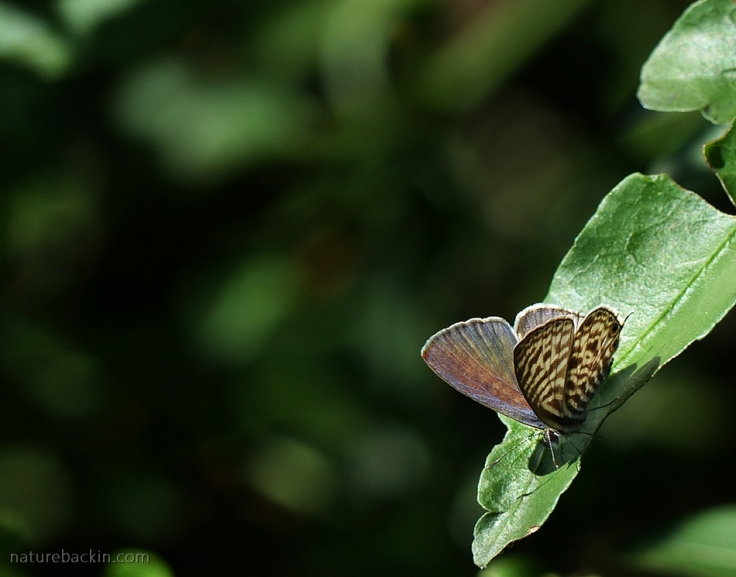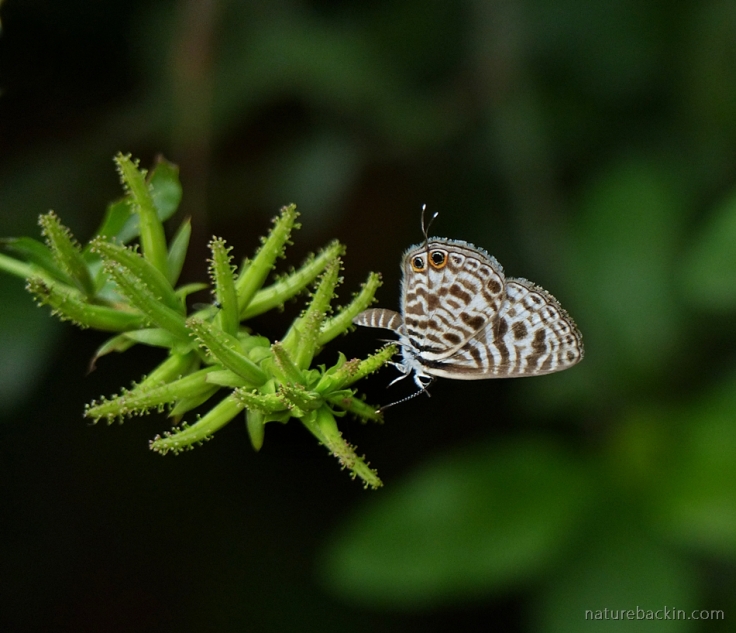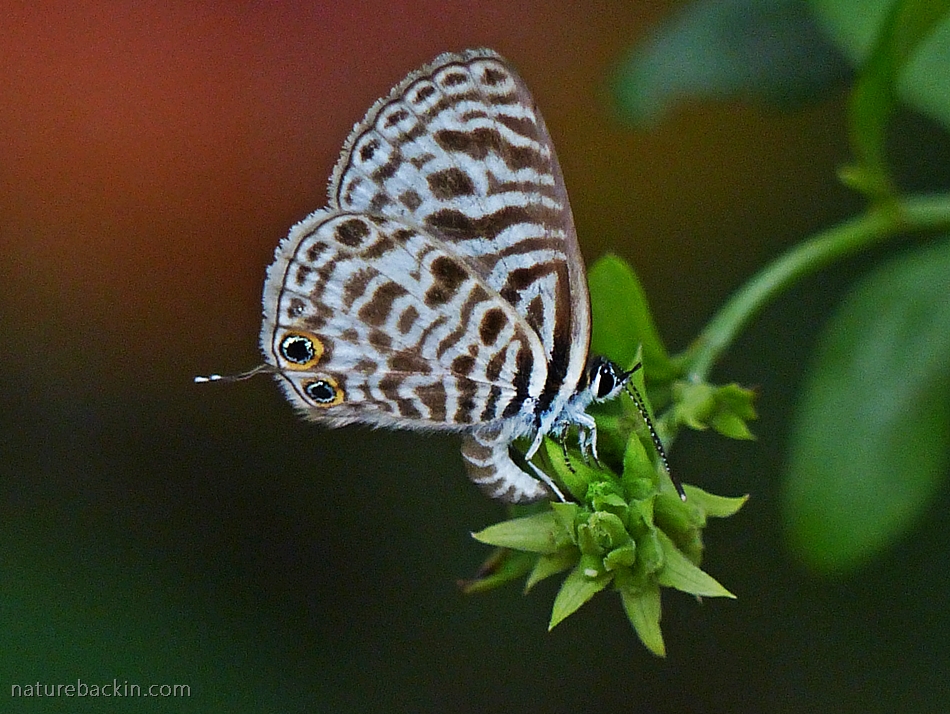Members of a subfamily of gossamer-winged butterflies known as “the blues” are common in our garden. It is only when they open their wings that their blue colouration is revealed. Although these butterflies are small – in the region of about one inch across from wingtip to wingtip – their markings can be intricately detailed.
I have been paying more attention to these little butterflies lately as I became aware that they are not all the same. Some are slightly smaller than others and the plants they visit vary. I started to notice that the markings on the underside of the wings may differ, though all have blue on the upperside of the wings, which is fleetingly visible when they are in flight. Usually when they settle they hold their wings closed and it is not often that I see them displaying the blue on the upperside of the wings.

One of the blues in our garden. The beginning of the powdering of blue on the upperside of the wings is just visible as the wings are held slightly open. This butterfly is one of the Zebra Blues
So, reading about them I learned that the blues belong to a subfamily or tribe (Polyommatinae) that occurs across the globe, and that several genera in this grouping occur also in Africa. One pantropical genus is known as the Zebra Blues (Leptotes), and depending on which sources you look at, four or five species of Zebra Blues occur in South Africa.

A Zebra Blue butterfly with its wings half open so as to reveal why it has this name: it is striped zebra-like on the underside of the wings, and is blue on the upperside of the wings. As the blue colour on the upperside of the wings extends to the edges of the wing, I think this is likely to be a male Zebra Blue butterfly
According to the book Gardening for Butterflies: Planning and Planting an Insect-Friendly Garden (by Woodhall and Gray) there are four species of Zebra Blue butterflies in South Africa, and these species are impossible to tell apart in the field (dissection is necessary to distinguish them). All four species use several species of indigenous leguminous plants as larval hosts, with the Common Zebra Blue (Leptotes pirithous), and possibly the Short-toothed Blue (Leptotes brevidentatus) too, also using Plumbago as a host plant.
In our garden Zebra Blue butterflies are noticeably attracted to our Plumbago auriculata (Cape leadwort) shrubs and also to the non-indigenous leguminous alfafa/lucerne (Medicago saliva) plants growing around our veggie patch.

A Zebra Blue butterfly, showing its two eye spots and the two small “tails” on the hindwings, perching on a Plumbago auriculata plant in our garden. The flowers have dropped and the seeds are developing in a cluster at the end of a stem
Being the commonest of the Zebra Blues and also seeing that it uses the Plumbago as a larval host it is likely that the Zebra Blues in these photos are Leptotes pirithous, that is the Common Zebra Blue, also known more simply as the Common Blue.
As proof that it is using the Plumbago as a larval host, on several occasions I have seen these butterflies ovipositing on a Plumbago in the garden. Those that I have seen have laid their eggs on the sticky seedheads at the end of the stems.

A Zebra Blue butterfly laying her eggs on the going-to-seed flowerhead of a Plumbago auriculata in our garden. Orange autumn flowers colour the background

This is what the Plumbago auriculata looks like before the flowers drop prior to the seeds developing. Indigenous to South Africa, Plumbago auriculata, also known as Plumbago capensis, has become a popular garden plant in many parts of the world
An entry in Wikipedia notes that the Common Zebra Blue (Leptotes pirithous), also known as Lang’s Short-tailed Blue, occurs in southern Europe (in Spain, France and Italy), along the Mediterranean coast, in Asia Minor up to the Himalayas, and in most of Africa and in Madagascar.

And here, showing that it is indeed at least partly blue, is one of the few usable photos I have managed to take of a Zebra Blue with its wings open. This one is settled on an alfafa/lucerne plant in our garden. I think this is a female as there is less blue than in the males. The hind parts of the wings are slightly damaged and the small tails are not visible
So there we have it – shades of blue and degrees of uncertainty – but there is no doubt these are lovely little butterflies to have flitting about, be they male or female and whatever species they may indeed be.
Sources:
Wikipedia. 2019. Leptotes pirithous. https://en.wikipedia.org/wiki/Leptotes_pirithous; Woodhall, Steve. 2013. Butterflies of South Africa. Pocket Guide. Cape Town: Struik Nature;Woodhall, Steve & Gray, Lindsey. 2015. Gardening for Butterflies: Planning and planting an insect-friendly garden. Cape Town: Struik Nature.
Posted by Carol









December 30, 2019 at 2:46 pm
ahh Blues, don’t tell me, It makes me headache
LikeLiked by 2 people
December 31, 2019 at 6:16 am
I am assuming you mean reality blues rather than musical blues – or perhaps both? Very sorry about that …
LikeLiked by 2 people
December 31, 2019 at 12:45 pm
No , I mean blue butterflies “Lycaenidae” i have many Species in my country and its hard to identify it
LikeLiked by 2 people
December 31, 2019 at 8:23 pm
Oh of course! Thanks Salimeh. I am laughing at my silly question 😁 Yes, we also have many species of hard-to-identify blue butterflies here in South Africa.
LikeLiked by 2 people
May 11, 2019 at 10:52 pm
Such beautiful captures of a difficult subject. Great job! ❤️
LikeLiked by 1 person
May 13, 2019 at 7:46 pm
Thanks so much Irene.
LikeLiked by 1 person
May 13, 2019 at 11:51 pm
You are welcome. 😊
LikeLiked by 1 person
May 6, 2019 at 6:00 am
The Blues are certainly beautiful to behold. I can’t imagine the patience it must have taken to capture these delightful images. It’s easy to see why people would want to plant that Plumbago. There aren’t too many flowers with that luscious blue. Good job, as always, Carol.
LikeLiked by 1 person
May 6, 2019 at 7:19 pm
Thanks very much Gunta. Yes the blue is lovely, and there is also a newish variety of Plumbago that has an even deeper blue. Photographing the butterflies was interesting and involved quite a bit of luck as much as anything else 🙂
LikeLike
May 5, 2019 at 11:37 pm
What is it about little blue butterflies and not showing their colors? We have the same thing here in Hawaii, particularly with lesser grass blue butterflies. I see their colors as they flit about but when they land, they fold their wings. Most uncooperative. Thanks for another beautiful and informative post.
LikeLiked by 1 person
May 6, 2019 at 4:42 am
Thank you Graham. Yes it is tantalising to mostly see only flashes of blue. It helps that even with folded wings they are lovely 😊
LikeLiked by 1 person
May 5, 2019 at 1:12 pm
I love the ‘Blue’ too… and am just as uncertain exactly which species unless I’ve had confirmation! xxx
LikeLiked by 1 person
May 5, 2019 at 7:55 pm
It is a special little presence this little butterfly. I am happy to think of them as Zebra Blues, without needing to be more specific 🙂
LikeLiked by 1 person
May 5, 2019 at 1:31 am
A beautiful butterfly! Here in the States the Monarch butterfly, big and orange and beautiful and plentiful in years past, is now endangered, and there has been a huge effort to help it. Fingers crossed for this year.
LikeLiked by 1 person
May 5, 2019 at 7:46 pm
Thanks. Yes I have read a bit about the Monarch in the States. Let’s hope efforts to help it not only benefit the Monarch butterfly, but has spin-offs for broader biodiversity too! Fingers crossed!
LikeLike
May 4, 2019 at 11:07 pm
You do pay attention, Carol. My favorite colors in nature are blues and golds. This Zebra Blue is lovely! One of your photos appears to capture a rainbow fluorescence inside one wing. Amazing! I am always moved by your deep and knowing connection to place, your place, your home. Thank you for sharing the wondrous beauty.
LikeLiked by 1 person
May 5, 2019 at 6:10 am
Yes it’s true – sometimes the scales on the upper side of the butterfly wings can have something like a fluorescent or luminous quality. Trying not to overlook and becoming aware of the extraordinariness of the ordinary can be healing even if somewhat addictive 😊 Thank you for your kind comment.
LikeLiked by 1 person
May 5, 2019 at 4:55 pm
A good addiction if it leads to a happy and healthy life. And sharing the bounty of it enriches the happiness and health of those of us who have a window into the extraordinary you discover.
LikeLiked by 1 person
May 5, 2019 at 4:59 pm
Hmm, “good addiction” might be an oxymoron. I honor your devotion to your craft, science, and art.
LikeLiked by 1 person
May 5, 2019 at 8:10 pm
I guess any line between addiction and devotion is likely to be extremely fine 🙂 Thank you very much though.
LikeLiked by 1 person
May 5, 2019 at 8:06 pm
Thank you – and I hope too that everyone has the chance to make their own everyday discoveries.
LikeLiked by 1 person
May 3, 2019 at 9:02 pm
Beautiful butterfly and super sharp images, brilliant!
LikeLiked by 1 person
May 4, 2019 at 7:11 pm
Thanks very much 🙂
LikeLiked by 1 person
May 3, 2019 at 10:35 am
Fabulous pictures and the butterflies are gorgeous, Carol. Great post.
LikeLiked by 1 person
May 3, 2019 at 2:35 pm
Thanks very much Kamal. Tiny butterflies can bring great cheer!
LikeLike
May 3, 2019 at 2:38 pm
Yes they sure can and they r so beautiful with their wonderful colors. Welcome always dear.
LikeLiked by 1 person
May 3, 2019 at 8:11 am
I am always fascinating to the diversity of butterflies. There are so many species I have never seen before. But I know plumbago… it is growing in my garden 😉
The first picture is a really eycatcher. The colours, shapes und the composition is just perfect!!
LikeLiked by 1 person
May 3, 2019 at 2:25 pm
Yes the diversity of butterflies seems almost endless – there are even variations within some species! Amazing how so many South African plants do so well in colder climates.
Thanks Simone, I am glad you like the first picture. I liked it too, though I am conscious that I am really pushing my bridge camera to do more than it is really cut out to do 🙂
LikeLiked by 1 person
May 3, 2019 at 3:53 pm
But the results are pretty convincing. 😊
LikeLiked by 1 person
May 3, 2019 at 7:26 am
Your garden seems particularly butterfly-rich. It’s early days here of course, but with every passing year, we seem to have fewer in our own gardens, and fewer varieties too. I’m impressed, by the way, by the blues you have captured in your photos. I can’t know how authentic they are, but they look pretty good, and blues are so hard to get right.
LikeLiked by 1 person
May 3, 2019 at 2:19 pm
Generally, we seem to have way fewer insects than some years back, sadly – particularly noticeable are fewer nocturnal insects.
The blues seem pretty true, though of course the device that one displays the images on can also make a difference!
LikeLike
May 3, 2019 at 6:33 am
Thank you Carol.Normally I dont pay much attention to Butterflies but with your information I can look at them with interest.
John
LikeLiked by 1 person
May 3, 2019 at 6:40 am
Thanks John There are so many at this time of the year, but most of them are mighty flighty. Tantalisingly so!
LikeLike
May 3, 2019 at 2:32 am
Your images and the information provided are stunning as always! We have such a fascinating variety of butterflies to boast with in South Africa, don’t you agree Carol?
We’ve actually got two posts about “Blue Butterflies” lined up in the coming weeks – our post about the Common Zebra Blue is scheduled to be published in two days in fact, to be followed next month by a post on the Pea Blue.
LikeLiked by 1 person
May 3, 2019 at 6:20 am
Thanks very much. Yes I agree. We see an incredible array of butterflies just in the garden.
What a remarkable coincidence that we both publish posts on the Common Zebra Blue in the same week! I look forward to seeing both your posts on the blues.
LikeLiked by 1 person
May 3, 2019 at 8:41 am
Great minds and all that!
Actually had loads of fun photographing them while we were in the ‘Berg, and gathered enough photos for a post all about them!
LikeLiked by 1 person
May 3, 2019 at 2:27 pm
Great minds indeed 🙂
It can be fun photographing butterflies, though many hardly perch at all. Must have been wonderful to spend time with butterflies in the Berg.
LikeLiked by 1 person
May 3, 2019 at 4:59 pm
Great way to loose complete track of time!
LikeLiked by 1 person
May 2, 2019 at 11:52 pm
These are such pretty little butterflies. You are lucky to have them in your garden.
LikeLiked by 1 person
May 3, 2019 at 6:16 am
Thanks Sandy. Our autumn is a particularly active time for butterflies in the garden.
LikeLiked by 1 person
May 2, 2019 at 10:47 pm
Great post about these sweet little butterflies, Carol. We have similar blues called Azures (Celastrina) with about 5 species in North America. It’s always a treat to see one.
LikeLiked by 1 person
May 3, 2019 at 6:14 am
Thanks Eliza. Yes they are sweet. Azures is a lovely name!
LikeLike
May 2, 2019 at 9:37 pm
Gorgeous! I just love butterflies so much
LikeLiked by 1 person
May 3, 2019 at 6:07 am
Thanks very much. Yes it’s hard to imagine not having a world with butterflies.
LikeLiked by 1 person